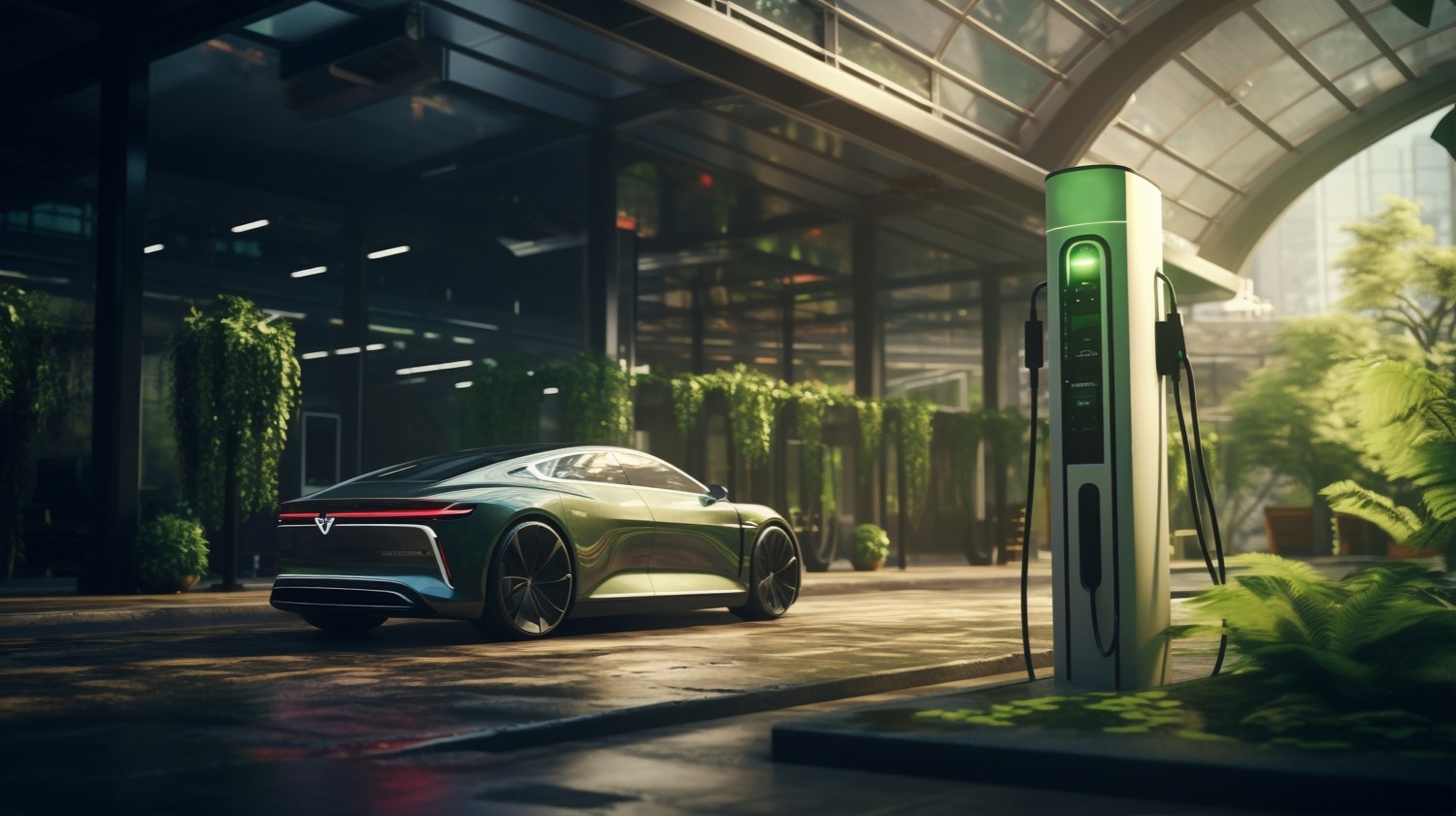Overview
E-mobility is a sustainable mode of transportation that uses electric vehicles (EVs) to reduce pollution, noise, and emissions. EVs offer numerous benefits, such as cost-effectiveness, powerful acceleration, and cutting-edge technology. These vehicles feature a lithium-ion battery that powers an AC induction or permanent magnet synchronous motor, and energy flow is managed for efficiency with power electronics. Advanced thermal management systems are also used to keep the EVs running smoothly. The future of e-mobility looks promising with the advent of solid-state batteries, intelligent charging stations, and responsible battery material sourcing and recycling. E-mobility presents an opportunity to reduce carbon footprints and make worthwhile investments. However, to support widespread EV adoption, a robust charging infrastructure, including public stations, home units, and smart grids, is required to manage electricity demand.
The e-mobility industry is still in its early stages but growing rapidly. Advancements in battery technology, charging infrastructure, and vehicle efficiency pave the way for a future where electric vehicles are the norm. As e-mobility continues to evolve, it will play a vital role in creating a cleaner and more sustainable transportation system.
Emerging Trends
- Powertrain Optimization: SiC inverters and electric motors with integrated gearboxes (EMGs) are two technologies that can significantly improve electric powertrains. SiC offers increased efficiency, reduced size and weight, higher power density, and faster charging. EMGs provide increased efficiency, reduced size and weight, simplified design, improved performance, reduced noise, lower maintenance, and improved reliability. Multi-speed transmissions offer better fuel savings, driving dynamics, and versatility, but implementing them requires careful investment vs. long-term return consideration.
- Battery Advancements: Advanced battery technologies are crucial for enhancing efficiency and reliability. Solid-state batteries are emerging as safer and more sustainable alternatives, with potential applications in various sectors. Battery advancements are focused on increasing energy density, boosting charging speeds, improving safety and reliability, and exploring alternative chemistries. Second-life batteries can be collected and refurbished from retired batteries, extending the battery lifecycle, reducing costs, and driving innovation. By embracing these strategies, businesses can unlock sustainable and cost-effective power solutions. Silicon anode technology is a promising breakthrough in battery tech, but it faces challenges such as rapid capacity loss and anode cracking. Researchers are working to improve these batteries' range, charging time, safety, and sustainability.
- Lightweighting and Materials: Lightweighting involves designing materials and structures to be as light as possible while meeting performance and safety standards. It has far-reaching benefits, reducing fuel consumption, improving efficiency, and making products easier to carry and store. Benefits include improved fuel efficiency, enhanced performance, extended product lifespan, and reduced environmental impact. 3D printing enables lightweight by allowing for the creation of complex internal structures, topology optimisation, and material versatility. This synergy between lightweight and 3D printing can improve performance, reduce environmental impact, and save costs in the aerospace, automotive, and medical industries.
- Connectivity and Software: V2X communication connects vehicles, traffic lights, and pedestrians for safer and more efficient roads. OTA updates allow automatic software updates, saving time and resources across various industries. Connectivity, software, and AI are the pillars of modern technology. They enable communication, bridge the gap between hardware and users, and add intelligence to machines for a bright future.
- Shared Mobility: Shared Mobility eMaaS is a new service that combines shared transportation with electric vehicles. This eco-friendly solution aims to reduce personal vehicle ownership, parking congestion, and carbon emissions. However, this service faces several challenges, such as scaling EV infrastructure and adapting policies. Micro-mobility, which includes ride-sharing and micro-mobility sharing, excels at short trips and reducing congestion. When combined, these services can create a sustainable transportation ecosystem. Nonetheless, challenges remain to overcome, such as ensuring safety and equity. In the future, we can expect to see fleets of electric vehicles charging at solar-powered stations seamlessly integrated with public transit apps.
- Wireless Charging: Wireless charging technology has revolutionised how we charge our devices. It allows you to charge your phone, tablet, or any other compatible device without having to plug in a cable. With wireless charging, you can place your device on a charging pad or stand, and it will start charging automatically. This eliminates the need for cables and makes charging more convenient and user-friendly.
- Vehicle-to-grid (V2G) Technology: Vehicle-to-grid (V2G) technology is a revolutionary concept that enables electric vehicles (EVs) to receive power from the grid and feed unused electricity back to the grid. This two-way flow of energy can help reduce the load on the grid during peak hours when energy demand is at its highest. The V2G system allows EVs to store energy during off-peak hours and discharge it when needed, making them a valuable resource for balancing the grid. This technology is gaining popularity as it enables EV owners to earn money by selling surplus electricity and helps utilities maintain grid stability and reduce carbon emissions.
- Autonomous Driving: Autonomous driving technology is a rapidly advancing field that has the potential to change how we travel significantly. The technology uses advanced sensors, cameras, and artificial intelligence to enable vehicles to operate without human intervention. This can revolutionise transportation as we know it, making it safer, more efficient, and more accessible for everyone. Autonomous driving can significantly reduce accidents caused by human error, leading to fewer road injuries and fatalities. It can also increase transportation efficiency by reducing congestion and optimising traffic flow. Additionally, autonomous vehicles can provide greater mobility to individuals unable to drive due to disabilities or other reasons, making transportation more accessible and convenient.
Use Cases
- Public Transportation: Electric buses, trams, and trains have emerged as a reliable and eco-friendly alternative to traditional fossil-fuel-powered vehicles for public transportation. These vehicles utilise electricity as their primary energy source, resulting in significantly lower emissions and a quieter ride. This not only helps to reduce the overall carbon footprint of cities but also improves residents' air quality. Electric public transportation is also more energy-efficient, requiring less energy than traditional public transportation options. As such, adopting electric public transportation can substantially reduce greenhouse gas emissions, making it a key component of sustainable and environmentally friendly urban transportation systems.
- Micromobility: Micromobility refers to shared and rented vehicles designed for short-distance trips within urban areas. These vehicles include electric scooters, bikes, and mopeds, which have become increasingly popular recently. They offer a convenient and eco-friendly alternative to traditional transportation methods, reducing traffic congestion and promoting sustainable urban mobility. City governments have also encouraged micro mobility vehicles to improve public transportation and reduce air pollution and carbon emissions. These vehicles are affordable, easy to use, and popular with commuters and tourists.
- Commercial Fleets: One of the most effective ways to promote a sustainable transportation system is by electrifying commercial fleets. This involves switching delivery trucks, taxis, and other commercial vehicles from traditional fossil fuel-powered engines to more environmentally friendly electric-powered engines. Doing so can greatly reduce harmful emissions and operating costs associated with traditional vehicles. This benefits the environment and helps businesses save money in the long run. Electrifying commercial fleets is important to building a cleaner, more sustainable future for all.
- Marine and Aviation: In recent years, the prospect of electric-powered boats and planes is increasingly being explored to reduce the environmental impact of the marine and aviation sectors. While there are still some technological challenges to overcome, electric propulsion has the potential to offer significant benefits such as reduced emissions, noise pollution, and lower operating costs. In the maritime industry, electric boats are already used for leisure and short-distance commuting, while smaller electric planes are being developed for regional travel in aviation. As research and development continue, electric propulsion will become more prevalent in the marine and aviation sectors, contributing to a more sustainable and eco-friendly future.
Perspective
The switch to e-mobility offers opportunities and challenges. It can reduce emissions and create economic prospects. However, battery range, charging times, and environmental issues remain concerns. Equitable access is crucial. With investment and supportive policies, e-mobility has the potential to revolutionise transportation and create a cleaner future.
There are several other factors contributing to the rise of e-mobility, including:
- Falling battery costs: The price of Lithium-ion batteries has declined rapidly in recent years, making EVs more affordable and competitive with gasoline-powered vehicles.
- Government incentives: Many governments offer tax breaks, rebates, and other incentives to encourage EV adoption.
- Improvements in charging technology: Charging times are getting shorter, and the range of EVs is increasing, making them more practical for everyday use.
- Growing environmental awareness: Consumers are becoming increasingly aware of the environmental impact of their transportation choices and are opting for EVs as a more sustainable option.
The future of e-mobility is bright. With continued innovation and investment, e-mobility can transform how we live and travel, creating a cleaner, healthier, and more sustainable future for all.
Velox Consultants is one of the fastest-growing market research and strategy consulting firms, recently recognised by Clutch. We specialise in providing customised research reports and Go-to-Market (GTM) strategies that cater to the specific needs of companies in the EV Components industry.
Our team of highly skilled professionals is well-equipped to help your company stay ahead in such a dynamic and competitive market. Explore how EV Components, from large corporations to aspiring entrepreneurs, can revolutionise your business. Please get in touch with us at consult@veloxconsultants.com.





